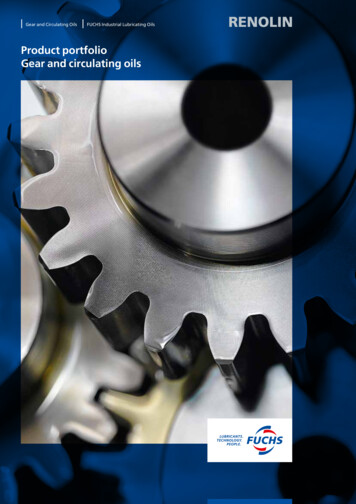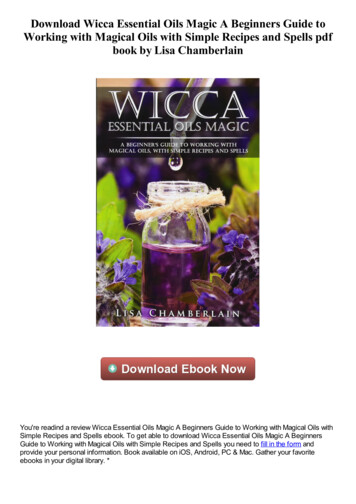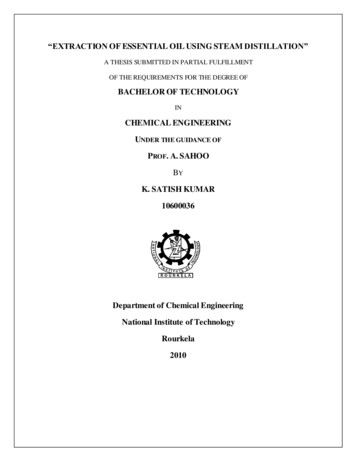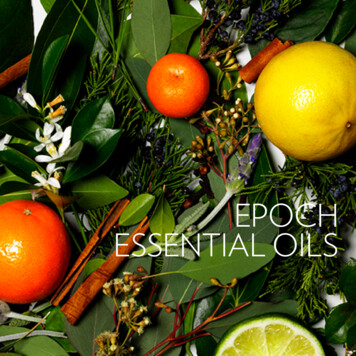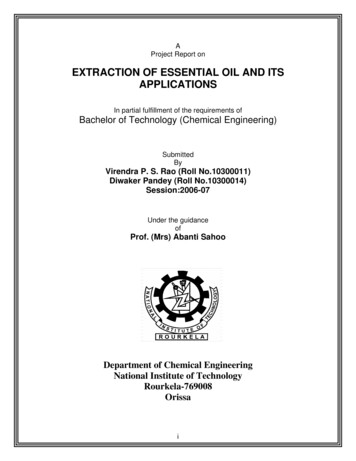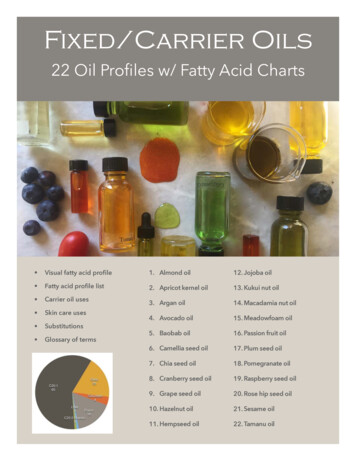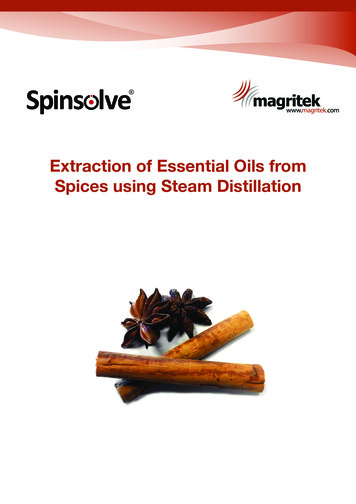
Transcription
RCarbonExtraction of Essential Oils fromSpices using Steam DistillationRCarbon
CarbonContentsObjectives 1Introduction 1Extraction of trans-anethole from star anise2Extraction of trans-cinnamaldehyde from cinnamon5Manuscript prepared by Dr. Almas I. Zayya, Dr. A. Jonathan Singh and Dr. Hemi Cumming.School of Chemical and Physical Sciences, Victoria University of Wellington, New Zealand.RCarbon
ObjectivesIntroductionThe principal aims of these experiments are toprovide experience in the extraction of essentialoils from spices using the steam distillationtechnique. Students will isolate and purify the keychemical compounds that contribute to the aromaand flavour of the spices. The compounds will thenbe characterised by NMR spectroscopy using thebenchtop Spinsolve NMR spectrometer.Extraction of the aroma and flavour componentsfrom dried plant materials is one of the oldestchemical operations developed by humankind.The preparation of a cup of tea or coffee is aneveryday example of extracting the flavour andaroma components, including the stimulantcaffeine, with hot water. In the followingexperiments, steam distillation is used to extractthe essential oils from two common spices: staranise and cinnamon bark (Figure 1). The mainessential oils responsible for the aroma and flavourof these spices are trans-anethole[1-methoxy-4-(1-propenyl)benzene] from star aniseand trans-cinnamaldehyde[(2E)-3-phenylprop-2-enal] from cinnamon bark.Steam distillation is a technique used to distillimmiscible liquids, for which steam providesone of the immiscible phases.1 The twosubstances mix in the gas phase and co-distill,but when cooled the desired componentseparates from water as it is immiscible.Steam distillation is commonly used to extractperfume and flavour oils from natural sources.Figure 1. Essential oils to be extracted from spices: trans-anethole from staraniseand trans-cinnamaldehyde from cinnamon.RCarbon1
Extraction of trans-anethole fromstar aniseA macroscale direct method for steam distillationis used to extract the essential oil, which iscomposed primarily of trans-anethole, from the staranise spice. In this method, the steam is generatedin situ by heating the ground dry spice material andwater in the distillation flask (Figure 2).ProcedureGrind two whole star anise seed pods (approximately3.5 g) in a mortar and pestle (Figure 3), andplace the ground material into a 100 mL 2-neckround bottom flask. Add water (40 mL) and beginthe distillation. After collecting about 20 mL ofcloudy distillate, add more water (20 mL) into thedistillation flask from the dropping funnel. Collect afurther 20 mL of distillate then stop the distillation.Combine the distillates in a separatory funneland extract with diethyl ether (2 20 mL). Dry theethereal layer with anhydrous magnesium sulfateand filter the solution. Remove the ether using arotary evaporator and collect the colourless staranise essential oil. Record your yield.SafetyDiethyl ether is highly flammable, handle withcaution. Magnesium sulfate is hazardous withrespect to ingestion, inhalation and skin contact.Deuterochloroform (CDCl3) is toxic, handle withcaution and do not ingest or inhale.Figure 2. Direct method steam distillation apparatus.Figure 3. Ground whole star anise seed pods.Tasks Calculate the yield of trans-anethole from the drymass of the seed pods. Assign the 1H NMR and COSY spectra to thestructure of trans-anethole. Record the 1H NMR and COSY spectra of transanethole using the Spinsolve NMR spectrometer.Prepare the NMR sample using a drop of the oil in0.6 mL of CDCl3.RCarbon2
NMR SpectraFigure 4. 1H NMR spectrum of trans-anethole, CDCl3.and 6 appear between 6.11-6.25 ppm as a broadmultiplet. The four aromatic protons at positions 2and 3 resonate as a second-order AA’BB’ systemwith two multiplets centred at 6.80 and 7.27 ppm.The 1H NMR spectrum of trans-anethole (Figure 4)shows a singlet (3H) at 3.78 ppm, correspondingto the methoxy (OCH3) group. A doublet (3H) isobserved at 1.85 ppm for the methyl group atposition 7. The two CH protons at positions 5RCarbon3
Figure 5. COSY spectrum of trans-anethole, CDCl3.methyl group at position 7. COSY correlations arealso observed between the four aromatic protonsat positions 2 and 3.The COSY spectrum of trans-anethole (Figure 5)clearly shows the correlations between the twoalkene CH protons at positions 5 and 6 and theRCarbon4
Extraction of trans-cinnamaldehydefrom cinnamonA macroscale direct method for steam distillationis also used to extract the essential oil, which iscomposed primarily of trans-cinnamaldehyde, fromthe cinnamon spice. In this method, the steam isgenerated in situ by heating the ground dry spicematerial and water in the distillation flask (Figure 2).SafetyDiethyl ether is highly flammable, handle withcaution. Magnesium sulfate is hazardous withrespect to ingestion, inhalation and skin contact.Deuterochloroform (CDCl3) is toxic, handle withcaution and do not ingest or inhale.ProcedureGrind two whole sticks of cinnamon (approximately5.5 g) in a mortar and pestle (Figure 6), andplace the ground material into a 100 mL 2-neckround bottom flask. Add water (40 mL) and beginthe distillation. After collecting about 20 mL ofcloudy distillate, add more water (20 mL) into thedistillation flask from the dropping funnel. Collect afurther 20 mL of distillate then stop the distillation.Combine the distillates in a separatory funneland extract with diethyl ether (2 20 mL). Dry theether layer with anhydrous magnesium sulfate andfilter the solution. Remove the ether using a rotaryevaporator and collect the colourless cinnamonessential oil. Record your yield.RCarbonFigure 6. Ground sticks of cinnamon.Tasks Calculate the yield of trans-cinnamaldehyde fromthe dry mass of cinnamon sticks. Record the 1H NMR and COSY spectra of transcinnamaldehyde using the Spinsolve NMRspectrometer. Prepare the NMR sample using adrop of the oil in 0.6 mL of CDCl3. Assign the 1H NMR and COSY spectra to thestructure of trans-cinnamaldehyde.5
NMR SpectraFigure 7. 1H NMR spectrum of trans-cinnamaldehyde, CDCl3.bond. The five aromatic protons at positions5, 6 and 7 appear as a broad multiplet centredat approximately 7.49 ppm. The CH proton atposition 3 should resonate as a doublet as itis coupling to the CH proton at position 3, butits signal is overlapping with the signal for thearomatic protons.The 1H NMR spectrum of trans-cinnamaldehyde(Figure 7) shows a doublet (7.3 Hz) at 9.73 ppmfor the aldehyde proton (CHO). The CH proton atposition 2 is observed as a doublet of doublets(16.0 Hz, 7.3 Hz) at 6.69 ppm, as it is couplingto both the aldehyde proton (7.3 Hz) and theother alkene CH proton at position 3. The 16.0Hz coupling constant between positions 2 and3 is indicative of (E)- geometry about the doubleRCarbon6
Figure 8. COSY spectrum of trans-cinnamaldehyde, CDCl3.positions 2 and 3 are also coupling to each other.COSY correlations are also observed between thearomatic protons at positions 5, 6 and 7.The COSY spectrum of trans-cinnamaldehyde(Figure 8) clearly shows the correlations betweenthe aldehyde proton (CHO) at 9.73 ppm and thealkene CH proton at position 2. The CH protons atRCarbon7
RReferences1) Pavia, D., L.; Lampman, G., M.; Kriz, G., S.; Engel, R., G. Introduction to OrganicLaboratory Techniques: A Small Scale Approach; Thomson Brooks/Coles, 2005.CONTACT INFORMATIONFor further information, please contact: sales@magritek.comGERMANYNEW ZEALANDPhilipsstraße 852068 Aachen, GermanyTel: 49 (241) 70525-6000Fax: 49 (241) 963 1429Or visit our website www.magritek.comRCarbon6 Hurring Place, Unit 3Newlands, Wellington 6037, NZTel: 64 4 477 7096Fax: 64 4 471 4665UNITED STATES6440 Lusk Blvd (D108)San Diego, CA 92121, USATel: 1 (855) 667-6835 1 (866) NMR-MTEK
the essential oils from two common spices: star anise and cinnamon bark (Figure 1). The main essential oils responsible for the aroma and flavour of these spices are trans-anethole [1-methoxy-4-(1-propenyl)benzene] from star anise and trans-cinn
